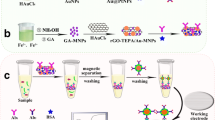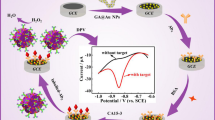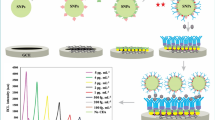Abstract
Herein we report a label-free amperometric immunosensor based on reduced graphene oxide-tetraethylene pentamine (rGO-TEPA) hybrid material co-modified by gold and iron-oxide magnetic nanoparticles (Au/MNPs-rGO-TEPA) for detection of carcinoembryonic antigen (CEA). The Au/MNPs-rGO-TEPA nanomaterials were prepared and coated on the working electrode as a sensing platform for antibody (anti-CEA) immobilization and signal amplification. This nanomaterial exhibited some excellent functionalities, such as magnetic and enhanced electrical properties due to its large specific surface area and favorable conductivity. Thionine (Thi) molecule was attached onto rGO-TEPA via π-π stacking and was used as an electrochemically active substance. The immunosensor was developed based on the increase in quantity of CEA captured, proportional to the decrease in peak currents of Thi. Under optimal conditions, the Au/MNPs-rGO-TEPA/Thi-based immunosensor showed impressive linear range from 0.1 pg/mL to 150 ng/mL. In addition, the proposed method had excellent linearity, high sensitivity, and relatively good stability, thereby offering a good platform for early clinical analysis.

A novel label-free binary nanoparticle-decorated reduced graphene oxide-tetraethylene pentamine-based electrochemical immunosensor was developed. Au/MNPs-rGO-TEPA/Thi was used as electrochemical sensitive platform for quantitative detection of CEA.







Similar content being viewed by others
Change history
08 February 2021
A Correction to this paper has been published: https://doi.org/10.1007/s12678-021-00642-1
References
M.A. Mohammad, T.A. Zahra, N. Sahraei, S.M. Moshtaghioun, Biosens. Bioelectron. 129, 1–6 (2019)
J.J. Miao, X.B. Wang, L.D. Lu, P.Y. Zhu, C. Mao, H. Zhao, Y. Song, J. Shen, Electrochemical immunosensor based on hyperbranched structure for carcinoembryonic antigen detection. Biosens. Bioelectron. 58, 9–16 (2014)
Y. Zhang, M.Y. Li, X.M. Gao, Y. Chen, T. Liu, J. Hematol, Oncol. 12, 137–137 (2019)
K. Njoku, D. Chiasserini, A.D. Whetton, E.J. Crosbie, Proteomic biomarkers for the detection of endometrial cancer. Cancers 11(10), 1572 (2019)
K. Honda, M. Ono, M. Shitashige, M. Masuda, M. Kamita, N. Miura, T. Yamada, Proteomic approaches to the discovery of cancer biomarkers for early detection and personalized medicine. Jpn. J. Clin. Oncol. 43(2), 103–109 (2013)
Y. Wang, J.P. Luo, J.T. Liu, X.R. Li, Z. Kong, H. Jin, X. Cai, Electrochemical integrated paper-based immunosensor modified with multi-walled carbon nanotubes nanocomposites for point-of-care testing of 17β-estradiol. Biosens. Bioelectron. 107, 47–53 (2018)
Y. Wang, H.R. Xu, J.P. Luo, J.T. Liu, L. Wang, Y. Fan, S. Yan, Y. Yang, X. Cai, A novel label-free microfluidic paper-based immunosensor for highly sensitive electrochemical detection of carcinoembryonic antigen. Biosens. Bioelectron. 83, 319–326 (2016)
F. Ahour, A. Shamsi, Electrochemical label-free and sensitive nanobiosensing of DNA hybridization by graphene oxide modified pencil graphite electrode. Anal. Biochem. 532, 64–71 (2017)
M.A. Tabrizi, M. Shamsipur, R. Saber, S. Sarkar, Simultaneous determination of CYC and VEGF165 tumor markers based on immobilization of flavin adenine dinucleotide and thionine as probes on reduced graphene oxide-poly(amidoamine)/gold nanocomposite modified dual working screen-printed electrode. Sens. Actuators B Chem. 240, 1174–1181 (2017)
Y. Fan, S.Y. Shi, J.S. Ma, Y.H. Guo, A paper-based electrochemical immunosensor with reduced graphene oxide/thionine/gold nanoparticles nanocomposites modification for the detection of cancer antigen 125. Biosens. Bioelectron. 135, 1–7 (2019)
J.M. Han, J. Ma, Z.F. Ma, One-step synthesis of graphene oxide–thionine–Au nanocomposites and its application for electrochemical immunosensing. Biosens. Bioelectron. 47, 243–247 (2013)
D. Wu, A.P. Guo, Z.K. Guo, L.L. Xie, Q. Wei, B. Du, Simultaneous electrochemical detection of cervical cancer markers using reduced graphene oxide-tetraethylene pentamine as electrode materials and distinguishable redox probes as labels. Biosens. Bioelectron. 54, 634–639 (2014)
Y.G. Wang, G.H. Zhao, Y. Zhang, X.H. Pang, W. Cao, B. Du, Q. Wei, Sandwich-type electrochemical immunosensor for CEA detection based on Ag/MoS2@Fe3O4 and an analogous ELISA method with total internal reflection microscopy. Sens. Actuators B Chem. 266, 561–569 (2018)
N.L. Li, L.P. Jia, R.N. Ma, W.L. Jia, Y. Lu, S. Shi, H. Wang, A novel sandwiched electrochemiluminescence immunosensor for the detection of carcinoembryonic antigen based on carbon quantum dots and signal amplification. Biosens. Bioelectron. 89(Pt 1), 453–460 (2017)
H. Wang, X.Z. Yuan, Y. Wu, H.J. Huang, X. Peng, G.M. Zeng, H. Zhong, J. Liang, M. Ren, Adv. Colloid Interf. Sci. 195, 19–40 (2013)
J.J. Shao, W. Lv, Q.H. Yang, Self-assembly of graphene oxide at interfaces. Adv. Mater. 26(32), 5586–5612 (2014)
S.Q. Yu, G.Z. Zou, Q. Wei, Talanta 156, 11–17 (2016)
G. Aygar, M. Kaya, N. Ozkan, S. Kocabiyik, M. Volkan, J. Phys, Preparation of silica coated cobalt ferrite magnetic nanoparticles for the purification of histidine-tagged proteins. Chem. Solids 87, 64–71 (2015)
Y.J. Liu, Y.Z. Wang, Q.Z. Dai, Y. Zhou, Magnetic deep eutectic solvents molecularly imprinted polymers for the selective recognition and separation of protein. Anal. Chim. Acta 936, 168–178 (2016)
Y. Luo, F.Y. Kong, C. Li, J.J. Shi, W. Lv, W. Wang, One-pot preparation of reduced graphene oxide-carbon nanotube decorated with Au nanoparticles based on protein for non-enzymatic electrochemical sensing of glucose. Sens. Actuators B Chem. 234, 625–632 (2016)
H.M. Ma, X.Y. Zhang, X.J. Li, R.X. Li, B. Du, Q. Wei, Electrochemical immunosensor for detecting typical bladder cancer biomarker based on reduced graphene oxide–tetraethylene pentamine and trimetallic AuPdPt nanoparticles. Talanta 143, 77–82 (2015)
Z.L. Tan, L.L. Cao, Y.Y. Yang, Q. Yan, Q. Liu, W. Zhang, P. Zhao, Y. Li, D. Zhang, Amperometric immunoassay for the carcinoembryonic antigen by using a peroxidase mimic consisting of palladium nanospheres functionalized with glutathione-capped gold nanoparticles on graphene oxide. Microchim. Acta 186(11), 693 (2019)
Z. Savari, S. Soltanian, A. Noorbakhsh, A. Salimi, M. Najafi, P. Servati, High sensitivity amperometric and voltammetric determination of persulfate with neutral red/nickel oxide nanowires modified carbon paste electrodes. Sens. Actuators B Chem. 176, 335–343 (2013)
K.Q. Jiang, D.X. Nie, Q.W. Huang, K. Fan, Z. Tang, Y. Wu, Z. Han, Thin-layer MoS2 and thionin composite-based electrochemical sensing platform for rapid and sensitive detection of zearalenone in human biofluids. Biosens. Bioelectron. 130, 322–329 (2019)
J. Lee, M. Morita, K. Takemura, E.Y. Park, A multi-functional gold/iron-oxide nanoparticle-CNT hybrid nanomaterial as virus DNA sensing platform. Biosens. Bioelectron. 102, 425–431 (2018)
Z. Zhao, H.D. Chen, L.N. Ma, D.J. Liu, Z. Wang, A label-free electrochemical impedance aptasensor for cylindrospermopsin detection based on thionine–graphene nanocomposites. Analyst 140(16), 5570–5577 (2015)
J. Lee, K. Takemura, C.N. Kato, T. Suzuki, E.Y. Park, Binary nanoparticle graphene hybrid structure-based highly sensitive biosensing platform for norovirus-like particle detection. ACS Appl. Mater. Interfaces 9(32), 27298–27304 (2017)
X. Wang, C.C. Chu, L. Shen, W.P. Deng, M. Yan, S. Ge, J. Yu, X. Song, An ultrasensitive electrochemical immunosensor based on the catalytical activity of MoS2-Au composite using Ag nanospheres as labels. Sens. Actuators B Chem. 206, 30–36 (2015)
S. Su, X.Y. Han, Z.W. Lu, W. Liu, D. Zhu, J. Chao, C. Fan, L. Wang, S. Song, L. Weng, L. Wang, Facile synthesis of a MoS2–Prussian blue nanocube nanohybrid-based electrochemical sensing platform for hydrogen peroxide and carcinoembryonic antigen detection. ACS Appl. Mater. Interfaces 9(14), 12773–12781 (2017)
R. Wang, J.J. Feng, Y.D. Xue, L. Wu, A. Wang, A label-free electrochemical immunosensor based on AgPt nanorings supported on reduced graphene oxide for ultrasensitive analysis of tumor marker. Sens. Actuators B Chem. 254, 1174–1181 (2018)
Q.L. Wang, H.F. Cui, X.J. Song, S.F. Fan, L. Chen, M. Li, Z. Li, A label-free and lectin-based sandwich aptasensor for detection of carcinoembryonic antigen. Sens. Actuators B Chem. 260, 48–54 (2018)
S.X. Lee, H.N. Lim, I. Ibrahim, A. Jamil, A. Pandikumar, N.M. Huang, Horseradish peroxidase-labeled silver/reduced graphene oxide thin film-modified screen-printed electrode for detection of carcinoembryonic antigen. Biosens. Bioelectron. 89(Pt 1), 673–680 (2017)
J.Y. Liu, J. Wang, T.S. Wang, D. Li, F. Xi, J. Wang, E. Wang, Three-dimensional electrochemical immunosensor for sensitive detection of carcinoembryonic antigen based on monolithic and macroporous graphene foam. Biosens. Bioelectron. 65, 281–286 (2015)
W.J. Qin, K. Wang, K. Xiao, Y.F. Hou, W. Lu, H. Xu, Y. Wo, S. Feng, D. Cui, Carcinoembryonic antigen detection with “Handing”-controlled fluorescence spectroscopy using a color matrix for point-of-care applications. Biosens. Bioelectron. 90, 508–515 (2017)
X.Q. Li, M.X. Yu, Z.C. Chen, X. Lin, Q. Wu, A sensor for detection of carcinoembryonic antigen based on the polyaniline-Au nanoparticles and gap-based interdigitated electrode. Sens. Actuators B Chem. 239, 874–882 (2017)
N. Shahbazi, S. Hosseinkhani, B. Ranjbar, A facile and rapid aptasensor based on split peroxidase DNAzyme for visual detection of carcinoembryonic antigen in saliva. Sens. Actuators B Chem. 253, 794–803 (2017)
Funding
We received support from National Natural Science Foundation of Guangxi key research and development program (Guike AB20072003), National Natural Science Foundation of China (61627807 and 81873913), Natural Science Foundation of Guangxi (2018GXNSFDA281044), China Postdoctoral Science Foundation (2019M653315), Guangxi Key Laboratory of Automatic Detecting Technology and Instruments (YQ20108), and Middle-aged and Young Teachers’ Basic Ability Promotion Project of Guangxi (2019KY0207).
Author information
Authors and Affiliations
Corresponding authors
Ethics declarations
Conflict of Interest
The authors declare that they have no conflict of interest.
Additional information
Publisher’s Note
Springer Nature remains neutral with regard to jurisdictional claims in published maps and institutional affiliations.
Rights and permissions
About this article
Cite this article
Xiao, H., Wei, S., Chen, Z. et al. Label-Free Electrochemical Immunosensor Based on Gold and Iron-Oxide Nanoparticle Co-modified rGO-TEPA Hybrid for Sensitive Detection of Carcinoembryonic Antigen. Electrocatalysis 11, 513–521 (2020). https://doi.org/10.1007/s12678-020-00604-z
Published:
Issue Date:
DOI: https://doi.org/10.1007/s12678-020-00604-z




